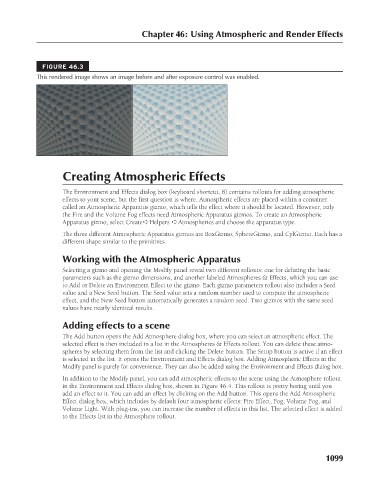Page 1147 - Kitab3DsMax
P. 1147
Chapter 46: Using Atmospheric and Render Effects
FIGURE 46.3
This rendered image shows an image before and after exposure control was enabled.
Creating Atmospheric Effects
The Environment and Effects dialog box (keyboard shortcut, 8) contains rollouts for adding atmospheric
effects to your scene, but the first question is where. Atmospheric effects are placed within a container
called an Atmospheric Apparatus gizmo, which tells the effect where it should be located. However, only
the Fire and the Volume Fog effects need Atmospheric Apparatus gizmos. To create an Atmospheric
Apparatus gizmo, select Create ➪ Helpers ➪ Atmospherics and choose the apparatus type.
The three different Atmospheric Apparatus gizmos are BoxGizmo, SphereGizmo, and CylGizmo. Each has a
different shape similar to the primitives.
Working with the Atmospheric Apparatus
Selecting a gizmo and opening the Modify panel reveal two different rollouts: one for defining the basic
parameters such as the gizmo dimensions, and another labeled Atmospheres & Effects, which you can use
to Add or Delete an Environment Effect to the gizmo. Each gizmo parameters rollout also includes a Seed
value and a New Seed button. The Seed value sets a random number used to compute the atmospheric
effect, and the New Seed button automatically generates a random seed. Two gizmos with the same seed
values have nearly identical results.
Adding effects to a scene
The Add button opens the Add Atmosphere dialog box, where you can select an atmospheric effect. The
selected effect is then included in a list in the Atmospheres & Effects rollout. You can delete these atmo-
spheres by selecting them from the list and clicking the Delete button. The Setup button is active if an effect
is selected in the list. It opens the Environment and Effects dialog box. Adding Atmospheric Effects in the
Modify panel is purely for convenience. They can also be added using the Environment and Effects dialog box.
In addition to the Modify panel, you can add atmospheric effects to the scene using the Atmosphere rollout
in the Environment and Effects dialog box, shown in Figure 46.4. This rollout is pretty boring until you
add an effect to it. You can add an effect by clicking on the Add button. This opens the Add Atmospheric
Effect dialog box, which includes by default four atmospheric effects: Fire Effect, Fog, Volume Fog, and
Volume Light. With plug-ins, you can increase the number of effects in this list. The selected effect is added
to the Effects list in the Atmosphere rollout.
1099

